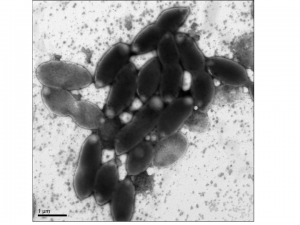 So our first attempt at entering the world of bacterial taxonomy and the description of a new species came out today with the thrilling title of “Porphyrobacter mercurialis sp. nov., isolated from a stadium seat and emended description of the genus Porphyrobacter“.
So our first attempt at entering the world of bacterial taxonomy and the description of a new species came out today with the thrilling title of “Porphyrobacter mercurialis sp. nov., isolated from a stadium seat and emended description of the genus Porphyrobacter“.
The story leading to this paper took us into a lot of new territory, some of which I’ve previously complained about here on microBEnet (e.g here). A quick bit of background; a few years ago we began a nationwide citizen science project to (among other things) collect built environment samples around the country and select 48 candidates to fly the International Space Station (ISS) for a growth competition. More information on the project can be found here. To this end we screened hundreds of bacterial colonies, looking for a diversity of organisms as well as to ensure that we only sent BSL-1 bacteria to the ISS. Picky those NASA folks.
Anyway, as one might expect we saw tons of Bacillus, Micrococcus, etc. Every full-length 16S sequence was shipped off to BLAST and we slowly worked our way through the list. One day however, I put in a sequence that showed only 95% identity over the entire 16S gene to anything with a name. Excited at the prospect of having a new species, we immediately set out to redo the sequencing… and got the same result. This particular bacteria had been collected by the Pop Warner youth cheerleading squad from a seat at the high school football stadium at Coronado High School near San Diego.
I thought that describing a new bacterial species would be a great undergraduate project so I offered it to Andrew Stump who had just joined our lab… turned out that he went to that high school! We began the process of trying to understand what was required for a formal description of a species so began the long slog. After Andrew moved on, another undergraduate, Jennifer Flanagan took on the project, and after she left Alex Alexiev took over the lab work.
I won’t rehash what I’ve posted about before, but there’s a lot of “old-school” microbiology involved in a species description. Much of which we had no experience with… for example lipid and fatty acid characterization. Some aspects seem insane to me that they still exist, for example DNA-DNA hybridization which is a notoriously finicky technique which also requires obtaining the DNA of all close relatives. Seems a bit outdated given the fact that we had sequenced the genome of our strain as the first order of business!
So we finally got it all together, described a new genus and species called “Kirrobacter mercurialis” and sent the paper off to PeerJ. It was their first species description so there was a bit of learning on both ends (proof of certificate of deposit of the strain in two culture collections for example).
If anyone out there thinks that open-access equates to easier or softer peer review… they should read the reviews that we got back on this paper. It was sent out to 3 reviewers all of whom trashed the paper in exquisite detail. I have never had a submitted paper so thoroughly dismantled in virtually every aspect. And they were right. The (sadly anonymous) reviews were all written by people who clearly had a lot more expertise in the field than we did. Thus began the second round… I spent an entire month just on phylogenetic trees.
At the end of which process we changed from the proposed new genus and species, to a new species within the existing genus of Porphyrobacter, for which we had to emend the formal description of the genus. The second round of review was also constructive, but much faster than the first round.
I love this paper for many reasons, though I’m aware that most people aren’t excited about yet-another-bacterial species since dozens come out every month. :)
Firstly, it was really interesting to learn more about the history of bacterial taxonomy since that history is reflected in things like the Bacteriological Code (which I didn’t even know existed!) and the rules for species descriptions. Digging into 0ld-school microbiology was also a blast. I also felt that this paper really reinforced the value and importance of peer review… it restored my faith in the system. And this was a citizen science project which was awesome to be a part of.
And lastly, this is probably the first ever description of a new species to contain the phrase “No statistically significant difference in growth was observed between earth and microgravity aboard the International Space Station (ISS).”